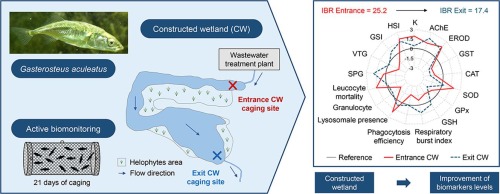Ecological Indicators ( IF 6.9 ) Pub Date : 2020-03-23 , DOI: 10.1016/j.ecolind.2020.106238 Audrey Catteau , Anne Bado-Nilles , Rémy Beaudouin , Sandrine Joachim , Olivier Palluel , Cyril Turiès , Christophe Galet , Alain Geffard , Jean-Marc Porcher

|
The present work aimed to assess the efficiency of a constructed wetland as tertiary treatment on urban wastewater with a multibiomarker approach using caged three-spined sticklebacks (Gasterosteus aculeatus L.). Fish were caged on three sites: at the entrance of the Constructed Wetland (CW), directly inside the wastewater effluent, at the exit of the CW, and in a weakly impacted site considered as a reference. After 21 days of caging, sticklebacks state of health was assessed using several biomarkers representing some biological functions such as innate immune and antioxidant systems, biotransformation enzymes, reproduction parameters and synaptic transmission. A strong inhibition of the innate immune system, an induction of EROD activity and an alteration of the hepatosomatic index were observed in fish caged at the entrance of the CW compared to those caged in the reference site. In addition, wastewater effluent induced a decrease of antioxidant system without induced oxidative damage on cell membranes. No improvement of these biomarkers was observed for antioxidant parameters at the exit of the CW. However, in fish caged at the exit of the CW, the EROD induction observed at the entrance was reduced and the innate immune system presented the same level compared to fish caged in the reference site, underlying the beneficial effect of the CW for these parameters. Integrated Biomarker response (IBR) was equal to 25.2 at the entrance of the CW and 17.4 at the exit of the CW which highlighted the global positive effect of the CW on water quality based on fish biomarker measurement.
中文翻译:

一种主动的生物监测方法,使用三棘棘背鱼(Gasterosteus aculeatus,L.)评估人工湿地作为三级废水处理的效率
本工作旨在通过使用笼罩式三刺棘背back(Gasterosteus aculeatus L.)的多生物标记方法评估人工湿地作为城市废水三级处理的效率。)。将鱼关在三个地点:在人工湿地(CW)的入口处,废水流出物的内部,在CW的出口处以及在受影响较弱的地点,这些地点被视为参考。笼养21天后,使用几种代表某些生物学功能的生物标记物(例如先天免疫和抗氧化系统,生物转化酶,繁殖参数和突触传递)评估了le背的健康状态。与在参考地点笼养的鱼相比,在化工厂入口处关养的鱼中观察到了对先天免疫系统的强烈抑制,EROD活性的诱导和肝体指数的改变。另外,废水流出物导致抗氧化剂系统的减少,而不会引起细胞膜的氧化损伤。在CW出口处未观察到这些生物标记物抗氧化剂参数的改善。然而,与在参考位置关在笼中的鱼相比,在CW关在笼中的鱼中,在入口处观察到的EROD诱导减少,先天免疫系统呈现相同水平,这说明了CW对这些参数的有益作用。综合生物标志物响应(IBR)在化武入口处等于25.2,在化武出口处等于17.4,这突出了基于鱼类生物标志物测量结果的化武对水质的全球积极影响。这些参数对CW的有益影响具有潜在意义。综合生物标志物响应(IBR)在化武入口处等于25.2,在化武出口处等于17.4,这突出了基于鱼类生物标志物测量结果的化武对水质的全球积极影响。这些参数对CW的有益影响具有潜在意义。综合生物标志物响应(IBR)在化武入口处等于25.2,在化武出口处等于17.4,这突出了基于鱼类生物标志物测量结果的化武对水质的全球积极影响。

























 京公网安备 11010802027423号
京公网安备 11010802027423号